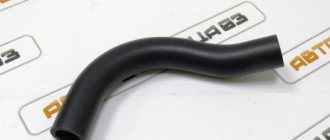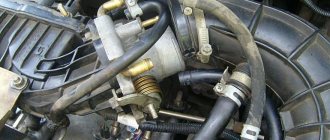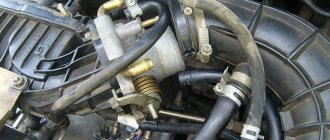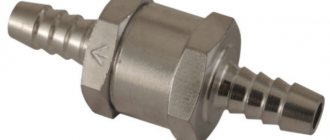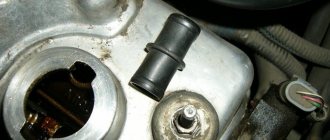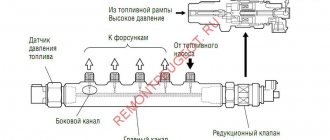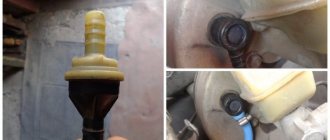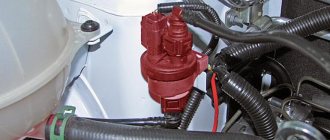Positive Crankcase Ventilation (PCV) is a positive crankcase ventilation system that controls the pressure in the oil system and removes exhaust gases from the crankcase, first cleaning them of oil particles. The PCV valve, also known as the positive crankcase ventilation valve (PCVV), is an integral part of the above-mentioned system.
This valve plays an important role and yet very often many people are not even aware of its existence. Thanks to it, the performance of the internal combustion engine is increased, and the risk of leakage and excessive oil consumption is reduced. However, if the PCV system malfunctions, it can cause the car owner many different problems. Recognizing the first signs of a faulty engine in a timely manner will allow you to save money and prevent more serious engine problems.
Topical: What happens if you don’t change your engine oil?
Diagram of the standard crankcase ventilation system
The crankcase ventilation system of VAZ engines consists of two circuits that operate at different load modes and speeds:
- The small ventilation circuit is connected to the valve cover and the intake manifold (behind the throttle body). This connection diagram provides intensive crankcase ventilation due to the vacuum that occurs in the intake manifold when the throttle is closed. To avoid an effect such as hyperventilation, the cross-section of the small circuit is limited by a jet in the cable throttle body with a diameter of 1.7 millimeters. This circuit operates in the region of 800-1500 rpm.
- A large ventilation circuit is connected to the valve cover and the air pipe (in the pre-throttle space). This scheme provides intensive crankcase ventilation at high speeds. The cross section of the large contour is 16-18 millimeters
Examples demonstrating the shortcomings of the standard crankcase ventilation system:
- A car is going down a hill with the gear in gear. In this mode, the engine operates at higher speeds with a reduced load. A high vacuum is created in the crankcase, and a large ventilation circuit is connected, in which there are no control valves. Since both circuits are connected to one volume of the oil trap, a strong vacuum in the crankcase will draw a fresh portion of air bypassing the throttle. The mass air flow sensor will show increased air flow, and the ECU will try to close the throttle. Having realized that this is not possible (it is already closed), the lean mixture will be corrected by increasing the fuel supply (fuel consumption will increase). As a result, the entire internal volume of the engine will work as a parallel receiver of very significant volume, connected to the intake, bypassing the throttle. It is this volume that will interfere with the formation of a high-quality mixture.
- A car in a traffic jam drives under tension with additional consumers (for example, the air conditioner is on). The compressor clutch is connected, the load increases abruptly. The engine does not have enough air, it begins to pull it from the crankcase, bypassing the throttle. But the ECU is also aware of the clutch engagement and also supplies more air by opening the throttle. The vacuum drops sharply, the vacuum brake booster (VBR) does not have enough strength to hold the car. Leap forward. The ECU sees an increase in oxygen and closes the throttle. A sharp increase in vacuum, VUT seizes. The car jerks, the transmission hits. And so on ad infinitum.
As a result, in both cases, when the engine is running, speed jumps occur and the engine choke under the load. Jerking and vibration are possible on manual transmissions, automatic transmissions and automatic transmissions. To eliminate these shortcomings, it is proposed to modify the design according to one of the presented schemes.
Auto parts and service stations
When a car engine operates, vapors and gases are formed not only in the engine block itself, but also in the crankcase or in the pan, which is designed to store oil and is located at the bottom of the engine. These are gases formed from oil, gasoline and water vapors. Also, gases formed during combustion of the fuel-air mixture can enter the crankcase through the gaps. All vapors and gases located in the crankcase are called crankcase gases. The concentration of such gases disrupts the properties of motor oil and has a harmful effect on the metal of engine parts. The crankcase ventilation system is used to remove the resulting gases. It consists of an oil separator, a crankcase gas valve and air exhaust pipes.Types of crankcase ventilation systems
Today, it is customary to distinguish two types of crankcase ventilation systems for automobile engines: open
, or ejection (exhaust gases are discharged directly from the crankcase using a special calibrated ejection tube) and
closed
, or forced ventilation system (
PCV - positive crancase ventilation
).
Open crankcase ventilation system
typical for power units of cars produced in the last century and now discontinued, although many of them still roam the vastness of the universe and domestic off-road. A special feature of this system is that the gases that escape from the cylinders, together with oil mist, are discharged outside the engine, directly into the environment. This method of ventilating the engine crankcase is distinguished by its simplicity and low cost of design, which, however, is “compensated” by significant atmospheric pollution.
Operating principle of the positive crankcase ventilation (PCV) system.
In addition to this disadvantage, open crankcase ventilation has a number of other negative aspects. Such a system is ineffective when driving at low speeds and is absolutely ineffective when the vehicle is stationary with the engine idling, because crankcase gas pressure is minimal. In addition, through an open crankcase ventilation system, when cooling a very hot engine, unfiltered atmospheric air can be sucked into the engine, along with dust and water vapor. There are often cases when, on cars with high mileage, an open-type system became the main cause of wear on the CPG and, as a consequence, loss of compression and oil consumption.
A more modern and effective alternative to open crankcase ventilation is a closed (forced) ventilation system. One of the key parts of such a system is the PCV valve, which removes gases trapped in the engine crankcase into the intake manifold and subsequent combustion in the combustion chambers. Different automakers implement the idea of closed ventilation in different ways, but in most cases, each of the schemes involves the presence of the same elements: a ventilation valve (PCV valve), an oil separator (there may be several, or internal ones - in the valve cover with a labyrinth and drainage holes oil, or external in the form of a separate structure with oil draining directly into the crankcase) and connecting pipes. It is worth noting that crankcase ventilation systems for gasoline and diesel engines have their own characteristics, but in general they have similar designs.
PCV System Operation
The principle of operation of the forced ventilation system is quite simple. When a vacuum occurs in the intake manifold, under its influence, the PCV valve opens and crankcase gases are supplied to the intake, and then, mixed with purified air, into the engine cylinders. To prevent the penetration of oil vapors into the combustion chamber, the system provides for the installation of an oil separator. Modern engines are equipped with a complex oil separator system. Thus, a labyrinth-type oil separator helps slow down the movement of gases from the crankcase. This ensures that oily droplets settle on the walls and then flow into the crankcase or under the valve cover.
In some modern engines, further purification of the oil from crankcase gases occurs using a centrifugal oil separator, which rotates the exhaust gases. Under the influence of centrifugal force, oil particles are retained on the walls and then flow into the crankcase. The final purification of oil from exhaust gases is carried out in the output labyrinth dampers.
PCV valve - design features.
The key role of the PCV valve in a closed crankcase ventilation system is to regulate the pressure of gases in the crankcase by bypassing them into the intake manifold and maintaining a vacuum in the intake manifold. In idling mode and during engine braking, the vacuum in the manifold is maximum (the throttle is only slightly open or completely closed), however, the amount of crankcase gases is not so large, so for complete ventilation a channel with a small flow area is sufficient. In this mode, under the influence of a large vacuum, the valve spool is completely retracted, but at the same time the crankcase gas bypass channel is largely closed, allowing only a small amount of them to pass through. When you press the accelerator pedal and under high loads, the amount of exhaust gases in the crankcase increases significantly. The valve spool is positioned in such a way as to ensure maximum channel throughput. There is also a so-called backfire mode, in which burning gases from the cylinder break into the intake manifold. In this case, the PCV valve is under pressure, not vacuum, and therefore closes completely, eliminating the possibility of igniting fuel and oil vapors in the crankcase.
Operating principle of the crankcase ventilation system
Layout of the crankcase ventilation valve The gases are cleaned from oil droplets, which subsequently flow back into the pan, and the purified gases enter the air supply system into the combustion chambers through the air pipes. The crankcase exhaust valve is responsible for the release of gases into the intake manifold. Cleaning from oil plays an important role, because it not only saves oil, but also combats carbon deposits on working parts. What is a crankcase ventilation valve for? The crankcase exhaust valve regulates the process of releasing accumulated vapors. The principle of its operation is based on the pressure difference in front of the valve and behind it. To understand how the ventilation valve works, let's look at its design. It consists of a plastic body, inlet and outlet fittings, two cavities, a membrane and a spring (forming a kind of piston). If there is a strong vacuum in the intake pipe, then under the action of a spring the valve closes and crankcase gases do not enter the air duct. If the throttle valve is fully open, the intake manifold is set to atmospheric pressure, or even higher in the case of turbocharging, and the valve is closed by external pressure. If a slight vacuum is created, the piston takes a neutral position and gases escape freely. The crankcase ventilation valve has only three operating positions. And because the resulting gases are supplied to the combustion chamber as a component of the working mixture, then the ventilation system is also called the recirculation system, and the valve is recirculation or in the English version - PCV valve, which means the same thing, and stands for Positive Crankcase Ventilation (in Russian - crankcase ventilation system ). Where is the crankcase ventilation valve located?
Where is the crankcase ventilation valve located?
or
An oil separator is located in the upper part of the crankcase. Usually, this is a combination of two types: labyrinth and centrifugal. The gases rise through both types of oil separator and then hit a valve, which is usually located in the intake manifold. How to check the crankcase ventilation valve? Checking the valve is fairly easy. Remove the hose that runs from the crankcase to the PCV valve. Start the engine. Plug the loose valve fitting with your finger. When the valve is operating, you will feel a vacuum being created. You will hear a click when the hole is released. If you do not feel a vacuum, then the crankcase ventilation valve has not passed the test. Malfunctions of the crankcase ventilation valve It is impossible to remove all oil particles when removing gas from the crankcase, so over time, contamination of the components of the ventilation system occurs. If the system is severely clogged, the pressure in the crankcase may increase and oil may escape through the dipstick or through the engine seals. A sign of oil getting into the combustion chamber is the appearance of an unpleasant odor and soot at the engine outlet. If urgent measures are not taken, this can lead to serious malfunctions in the cylinder-piston group. If oil deposits appear on the intake manifold and air filter, this indicates problems with the oil trap.
Signs of a malfunctioning crankcase ventilation system
In the event of a malfunction of the labyrinth system (significant clogging with coked oil), a small but noticeable oil consumption occurs (in the region of 0.1-0.5 liters per 1000 km), traces of burnt oil appear on the spark plugs in the form of grains or “rust”, and in the combustion chamber - carbon deposits, all this is mistakenly mistaken for dead valve stem seals or even rings, although this is not the problem at all. In some cases, especially in the cold season and when driving slowly through traffic jams, oil mist may gradually settle in the form of liquid oil directly in the intake manifold, which leads to cold start problems; when starting, oil from the runners enters the intake and floods everything around, in incl. spark plugs, valves and combustion chamber, interfering with normal mixture formation and ignition of the combustible mixture. And when the start is successful, the trapped oil begins to burn in the form of blue smoke, which is again attributed to dead valve stem seals... but in fact, you need to dig into the crankcase ventilation system. Incorrect operation of the PCV system may be one of the reasons for contamination of the throttle, idle air valve, contamination of the air filter, air line (pipe pipes and intake manifold), oil leakage and squeezing of oil seals and gaskets, more often outward than inward. Clogged ventilation system pipes create excess pressure in the engine crankcase, as a result of which exhaust gases along with oil will seek alternative exit routes. At the initial stages, when the system associated with the PCV valve is clogged (most often the valve itself is clogged, less often the oil separator, labyrinths and pipes are clogged), the ventilation begins to work incorrectly and oil vapors along with gases begin to flow through the ventilation tube, the first sign of this is rapid contamination of the throttle from the inlet side. In some cars, fresh air is taken directly from the air filter box - if the PCV system malfunctions, the filter begins to fill with oil, and in some cases, because crankcase gases are very hot, it is even possible that the filter made of synthetic material will melt and, as a result, the car will be deprived of the air filtration system. In cases where both tubes are already clogged, the consequences are more dire, the dipstick begins to throw out, and the formation of oil smudges in the places of seals and connections (gaskets, oil seals) is also possible. A completely unpleasant option is squeezing out the crankshaft seals or oil filter seals with significant losses in oil volume. Incorrect operation of the PCV valve itself can lead to incorrect metering of incoming air, and the preparation of an over-rich or over-lean mixture, depending on the operating mode. If the valve begins to allow gases to pass in all directions (the pistons or springs are destroyed), a strong air leak into the intake manifold begins, the vacuum in it drops, with all the troubles in the form of increased fuel consumption, unstable or increased idle speed, depletion of the combustible mixture, deterioration operation of the vacuum brake booster. Moreover, the Check Engine may not light up, because There are usually no misfires.
As a rule, a typical malfunction of the KVKG is the wear of the membrane, as in the photo below. It breaks, creating the above problems.
Replacing the KVKG using the example of the M43 BMW engine. Video:
Schemes for upgrading the crankcase ventilation system
Schemes for modifying the crankcase ventilation system, as well as a description, are provided by IgorRV.
For LADA cars with manual transmission and AMT (“robot”), scheme No. 1 “Crankcase ventilation scheme with PCV valve for E-GAS and cable throttle” is suitable:
It is necessary to install a PCV valve (article 94580183, price about 400 rubles) from a foreign car into the small crankcase ventilation circuit. When connecting the PCV valve to a small circuit on an E-GAS, use a new hose (petrol-oil-resistant 8 mm without fabric reinforcement). On a cable choke, connect to the receiver, not to the choke.
As a result, the valve will shut off the circuits in transient modes, which will allow:
- Accept the load without jerking or dropping engine speed (for example, when the compressor is running, heated windows, seats, etc.).
- Reduce vibration load at idle
- Increase traction from the bottom (noted by owners of automatic transmission with VAZ-21126 engine, manual transmission with VAZ-21227, 21126 and 11186 and AMT with VAZ-21127).
- Get a sharper response to the gas pedal and faster shifts (on AMT). Perhaps due to the fact that the valve does not allow the engine to slow down, maintaining a more optimal switching algorithm.
- Reduce oil consumption through ventilation.
The valve replacement period is 40,000 km.
For LADA cars with automatic transmission (Jatco) and AMT (“robot”), scheme No. 2 is suitable:
Description of scheme No. 2: The pressure reducing valve is connected in series to a large ventilation circle. Thus, it regulates the flow of crankcase gases at high speeds and during transient processes. This allows:
- Exercise full control over the flow of crankcase gases between the small and large circuits.
- Improve engine operating mode.
- Reduce vibration load.
- Reduce oil release into ventilation.
For LADA cars with automatic transmission (Jatco) and AMT (“robot”), scheme No. 3 is suitable:
Description of scheme No. 3: To improve the operation of the braking system and facilitate the process of holding the car on the brakes in mode “D”, an “Ejection Pump” was used. Due to the flow of crankcase gases from the small circuit, the vacuum in the tube leading to the vacuum booster increases. This happens at low speeds, which is very helpful when driving in traffic jams. Keeping your foot on the brake all the time is not very easy, but this pump makes the task easier.
- Getting rid of vibrations, failures, transmission shocks.
- The engine begins to operate more calmly and softly.
- The force on the brake pedal becomes less.
- The air conditioner turns on almost imperceptibly.
- ejection pump (article 10793 VIKA, price 546 rubles);
- pressure reducing valve (article 1117701500 JP GROUP, 422 rubles);
- PCV valve (article 94580183 GENERAL MOTORS, 400 rubles);
- clamps (about 10 pieces, 600 rubles);
- thin, petrol-resistant 8 mm hose 50 cm (100 rubles);
- standard ventilation pipe.
Installing the PCV valve on Granta
:
Installing the PCV valve on Vesta:
By the way, there are other ways to modify the crankcase ventilation system. Are you ready for such modernizations? Let us remind you that modification of the ignition system (installation of capacitor ignition coils in the harness) is also common among owners of LADA cars.
Video
Welcome! The crankcase ventilation system is needed so that the atmosphere is not clogged and the exhaust gases are allowed to burn out again, this system was implemented in many cars, starting from the VAZ 2101 and ending with cars such as Lada Priora, Lada Granta, etc., but when the engine is worn out, this system is removed by the people themselves by removing all the hoses of the crankcase ventilation system, usually into a bottle, or just outside, we will analyze this in this article, so if your car has already covered quite a lot of mileage, then this article will be useful to you benefit.
Note! We will only disassemble cleaning the ventilation on 16 valve engines; if you have an 8 valve engine, then go to the article: “Cleaning the crankcase ventilation on a VAZ 2114”, in this article this engine is described; to clean the crankcase ventilation of a 16 valve engine, you will need stock up on: Small pliers, screwdrivers with different heads and all kinds of wrenches; in addition, you will need sealant for the cylinder head cover and a new gasket!
Disadvantage of the standard VAZ ventilation system
The system consists of two circuits that operate at different load modes and speeds:
- — The small ventilation circuit is connected to the valve cover and the intake manifold (behind the throttle space). This connection diagram provides intensive crankcase ventilation due to the vacuum that occurs in the intake manifold when the throttle is closed. To avoid an effect such as hyperventilation, the cross-section of the small circuit is limited by a jet in the cable throttle body with a diameter of 1.7 millimeters. This circuit operates in the region of 800-1500 rpm.
- — A large ventilation circuit is connected to the valve cover and the air pipe (in the pre-throttle space). This scheme provides intensive crankcase ventilation at high speeds. The cross section of the large contour is 16-18 millimeters
Let's consider an example when a car is going down a hill with the gear engaged. In this mode, the engine will operate at higher speeds with a reduced load. A high vacuum is created in the crankcase, and a large ventilation circuit is connected, in which there are no control valves. Since both circuits are connected to one volume of the oil trap, a strong vacuum in the crankcase will draw a fresh portion of air bypassing the throttle. The mass air flow sensor will show increased air flow, and the ECU will try to close the throttle. Having realized that this is not possible, it is already closed, the lean mixture will be corrected by increasing the fuel supply (fuel consumption will increase).
As a result, the entire internal volume of the engine will work as a parallel receiver of very significant volume, connected to the intake, bypassing the throttle. It is this volume that will interfere with the formation of a high-quality mixture. A similar situation occurs in a traffic jam when driving in tension with additional consumers (for example, the air conditioner is on). The author of the idea explains in more detail.
How to clean the crankcase ventilation system on a VAZ 2110-VAZ 2112?
Note! Before you start work, remove the air filter housing, as it will interfere greatly; if you do not know how to do this, then read the article entitled: “Replacing the air filter housing on dozens”!
Removal: 1) The hardest thing is to remove the cylinder head cover, but the remaining parts that relate to the ventilation system (And these are mainly hoses), removing is as easy as shelling pears, in general, let's start, first you will need to disconnect the wires from each other, namely the upper connectors (see photo 1 ) and lower connectors (Indicated by a red arrow), once this is done, remove the connectors, to do this, squeeze the two latches on one connector with your fingers and remove it (see photo 2) and do the same with the other connector, just without removing it, they will interfere, and in general you won’t be able to remove the cylinder head cover without removing these connectors, because the wires simply won’t allow you to do this, both connectors were sitting on brackets, so unscrew the bolts securing them and remove both brackets from the cylinder head cover, in more detail how to do this , look at photos 3 and 4 below.
2) Now remove the exhaust manifold from the cylinder head cover, it is bolted on and by the way, when you remove it, replace all the O-rings, firstly they are not expensive and secondly, after replacement, you will be 100% sure that the collector will not let air through anywhere, since the rings will be new; you can read in more detail how to do this in the article entitled: “Replacing the receiver on a 16-valve car.”
Stories from our readers
“Fucking basin. "
Hi all! My name is Mikhail, now I’ll tell you a story about how I managed to exchange my two-wheeler for a 2010 Camry. It all started with the fact that I began to be wildly irritated by the breakdowns of the two-wheeler, it seemed like nothing serious was broken, but damn it, there were so many little things that really started to irritate me. This is where the idea arose that it was time to change the car to a foreign car. The choice fell on the melting Camry of the tenth years.
Yes, I had matured morally, but financially I just couldn’t handle it. I’ll say right away that I am against loans and taking a car, especially not a new one, on credit is unreasonable. My salary is 24k a month, so collecting 600-700 thousand is almost impossible for me. I started looking for different ways to make money on the Internet. You can’t imagine how many scams there are, what I haven’t tried: sports betting, network marketing, and even the volcano casino, where I successfully lost about 10 thousand ((The only direction in which it seemed to me that I could make money was currency trading on the stock exchange, they call it Forex. But when I started delving into it, I realized that it was very difficult for me. I continued to dig further and came across binary options. The essence is the same as in Forex, but it’s much easier to understand. I started reading forums, studying trading strategies. I tried it on a demo account, then opened a real account. To be honest, I didn’t manage to start earning money right away, until I understood all the mechanics of options, I lost about 3,000 rubles, but as it turned out, it was a precious experience. Now I earn 5-7 thousand rubles a day. I managed to get the car buy after half a year, but in my opinion this is a good result, and it’s not about the car, my life has changed, I naturally quit my job, I have more free time for myself and my family. You’ll laugh, but I work directly on the phone)) If If you want to change your life like me, then here’s what I advise you to do right now: 1. Register on the site 2. Practice on a Demo account (it’s free). 3. As soon as you get something on the Demo account, top up your REAL ACCOUNT and go to REAL MONEY! I also advise you to download the application to your phone, it’s much more convenient to work from your phone. Download here.
PCV Valve Installation
You will need : crankcase ventilation valve (article) 94580183 (approximate price 400 rubles), a new hose.
The PCV valve is connected in series to a small circuit (in a cable throttle it is connected to the receiver), closing it when the vacuum increases and does not exist. This scheme requires a minimum of alterations and is used on the vast majority of foreign cars. Before installing the valve, make sure it only vents towards the receiver side (not the valve cover side).
The installation process is very simple: remove the old hose, take a new one and put the PCV valve in the cut, with the blue end towards the receiver (photo by Barmalej79).
What does modification give?:
- — reduction of vibration load at XX;
- — better reception of the load from the air conditioner and other powerful consumers such as windshield heating, seat heating and others;
- — increasing the moment from the bottom;
- — reduction of oil consumption through ventilation.
According to owners, this modification has a positive effect on engine performance. Are you ready to try? By the way, read other upgrades to the crankcase ventilation system.
Will you install a PSV valve in the crankcase ventilation system of a VAZ?
Source
Consequences of faulty crankcase ventilation
Consequences of high pressure in the crankcase:
- Damage to the rubber seals of the crankshaft and camshaft. The engine will lose oil through squeezed out oil seals. If a sharp decrease in level is not noticed in time, oil starvation can lead to wear of the rubbing pairs and rotation of the liners.
- Turbine failure. After lubricating and cooling the turbocharger parts, the oil should drain by gravity into the pan. If there is a backlash of gases in the crankcase space (a kind of plug), the volume of engine oil pumped through the turbine will sharply decrease. Due to deterioration of heat dissipation, the oil will begin to coke inside the channels and on hot rubbing vapors. The consequence is scuffing on the liners and turbine shaft, which is equivalent to a deep restoration or replacement of the cartridge/turbocharger assembly.
- Squeezing out the dipstick and splashing oil into the engine compartment. In some cases, the dipstick flies out with such force that it leaves a noticeable dent in the hood. In this case, you won’t be able to get rid of it just by washing the engine compartment.
Video: Crankcase ventilation system
PCV valve
The crankcase ventilation valve (CVG) or PCV (Positive Crankcase Ventilation) is used to effectively use the gas mixture formed in the crankcase . The part is installed on most modern models with a fuel injection system and is directly involved in regulating the composition of the air-fuel mixture. Incorrect operation of the VKG valve leads to excessive fuel consumption and unstable operation of the internal combustion engine .
Where is the PCV valve located and what is it for?
The location of the PCV valve directly depends on the vehicle modification. Usually the part is built into the valve cover of the internal combustion engine, but can also be placed in a separate housing, combined with an oil separator, close to it. The latter option is actively used in the latest generations and models of BMW and Volkswagen.
You can find the crankcase ventilation valve by the thin flexible pipe extending from it, connected to the air duct in the area between the intake manifold and the throttle.
You can see what the crankcase gas valve looks like in the photo with a clear example.
Where is the crankcase ventilation valve on a VW Golf 4, click to enlarge
Where is the pcv valve located in the Audi A4 2.0, click to enlarge
Location of KVKG on Toyota Avensis 2.0, click to enlarge
What does the crankcase ventilation valve do?
The main purpose of the PCV valve is to regulate the volume of crankcase gases supplied to the throttle body in various operating modes of the internal combustion engine. This achieves more precise air dosing to create an optimal air-fuel mixture ratio. Additionally, the KVKG prevents the ignition of crankcase gases during a backfire in the intake.
Cost of the KG ventilation valve
The cost of KVKG can be completely different; the price largely depends on the car model and the engine itself. For example, an original valve for an M54 (BMW) internal combustion engine costs about 2200-2400 rubles; this device is also suitable for M52 series engines and is installed on E39 5-series cars, X3, X5, BMW Compact. For Ford cars (Duratec HE engines), a ventilation valve can be purchased at an average price of 1300-1800 rubles, the cost depends on the seller - custom parts are cheaper if the parts are not needed urgently.
There are original parts that are quite expensive, and besides, they cannot always be found on sale, so it makes sense to buy contract spare parts - they are much cheaper and more accessible. For example, even a contract Mitsubishi KVKG for the 4G94 engine from Vladivostok will cost about 3 thousand rubles; it is difficult to say how much the new mechanism costs. You can also search for more details in car dismantling yards and various advertisements on the Internet.
Sources
- https://MoyLacetti.ru/sistema-ventilyacii-kartera/
- https://akki-carsh.ru/dvigatel/chistka-sistemy-ventilyacii-karternyh-gazov.html
- https://avtomotoprof.ru/obsluzhivanie-i-uhod-za-avtomobilem/ventilyatsiya-kartera-dvigatelya/
- https://VazNeTaz.ru/klapan-ventilyacii-karternyx-gazov
- https://vopros-avto.ru/klapan-pcv-chto-eto-i-dlya-chego-priznaki-neispravnosti-klapana-pcv-i-sposoby-proverki/
- https://santavod.ru/kak-proverit-klapan-ventilyaczii-karternyh-gazov-pcv/
- https://avtobrands.ru/znachenie-sistemy-ventilyatsii-karternyh-gazov-v-dvigatele/
- https://MoyLacetti.ru/klapan-pcv/
- https://avtika.ru/kakuyu-ventilyatsiyu-kartera-imeyut-bolshinstvo-avtomobilnyh-dvigateley/
- https://FB.ru/article/299022/kak-proverit-klapan-karternyih-gazov
Design and how the crankcase ventilation valve works
VKG valve design: video
Structurally, this part in the ventilation of crankcase gases is a bypass valve, consisting of a housing with two pipes and a movable working element.
In built-in PCV valves, the inlet and outlet openings are blocked by a plunger, and in those located in a separate housing with an oil separator - by membranes. Free movement of the locking element without external influence is prevented by springs.
How does the VKV valve work?
The operating principle of the PCV valve is based on changes in inlet pressure. Conventionally, we can distinguish 4 main states of the crankcase gas valve according to the degree of opening and the amount of passing crankcase gases.
The degree of opening of the PCV valve depending on the operating mode of the internal combustion engine
| Modes | Engine not started | Idling/deceleration | Uniform movement, medium speed | Acceleration, high speed |
| Vacuum in the intake manifold | High | Average | Low | |
| PCV Valve Condition | Closed | Ajar | Normally open | Fully open |
| The amount of passing crankcase gases | Small | Average | Big |
From the inlet side, the valve is exposed to pressure created by crankcase gases. When it exceeds the spring force, the element blocking the hole (membrane or plunger) moves inward, allowing the gas mixture to enter the filter housing.
VKV valve design in VW Polo
KVKG filling in the Chevrolet Lacetti
At the same time, from the outlet side, the valve is affected by a vacuum (pressure below atmospheric) created in the intake manifold. Limiting the valve flow area allows you to redirect some of the gases from the crankcase that have collected under the valve cover into the space between the air filter and the throttle valve. In the event of a backfire and a sharp drop in vacuum in the intake manifold, the outlet of the CVCG is completely blocked, thereby preventing ignition of the flammable gas mixture.
What does the PCV valve do?
PCV Valve Operating Modes
The PCV valve directly affects engine operation, optimizing the mixture formation process. By changing the flow area of the channel, it adjusts the flow of crankcase gases containing fuel particles into the air channel in front of and behind the throttle. This allows you to use the crankcase ventilation system as efficiently as possible and at the same time prevent the entry of unaccounted fuel-air mixture into the intake manifold.
When the crankcase ventilation valve fails, they are supplied to the intake in excess quantities or not at all. Moreover, in the first case this is usually not detected by any sensors, and in the second it leads to attempts at unjustified correction of the air-fuel mixture.
Due to the excess air entering the combustion chamber, the engine starts worse, failures are possible during acceleration or in other cases when it is necessary to increase thrust. Valve jamming can lead to increased fuel consumption and over-enrichment of the fuel assembly, resulting in unstable operation and vibration of the engine at idle speed.
Valve in the crankcase ventilation system
SVKG device in Lada Priora
In all brands of cars, the SVKG is built on a similar principle. Only small details differ. On the upper side of the crankcase there is an oil separator, which looks like a hollow plug. An oil deflector is placed under the plug, which is designed to clean the gases from the crankcase as much as possible from oil particles. The oil separator has an outlet for the crankcase ventilation hose.
In order for the gases to return to the cylinder chamber, a ventilation valve is placed along their path. The valve has three modes, which allows you to maintain a certain level of gas rarefaction in the crankcase.
While the engine is idling, gases move through a small circuit hose through a special passage hole in the throttle assembly. At this time, a high vacuum is created in the intake hose, which allows crankcase gases to be effectively sucked out of the throttle block. The passage hole in the throttle regulates the amount of gases that are sucked out.
This allows you to stabilize the engine in idle mode. When the car begins to move, the throttle valve opens, causing gases from the crankcase to enter the cylinder through a large circuit hose for combustion.
Signs and Causes of a Malfunctioning PCV Valve
Stuck engine speed due to PCV valve and fixing the problem: video
Although the crankcase ventilation valve has a simple device, from time to time it still fails or does not work correctly. What may be signs of a faulty VCG valve? Most often this is:
- engine vibration other than vibration;
- hissing in the intake manifold after gas release;
- dip in traction from 3000 to 5000 rpm;
- XX rpm fluctuation.
If there are accompanying problems in crankcase ventilation, it is possible that oil consumption may increase and the throttle valve and ventilation hoses leading from the crankcase may become oily.
What malfunctions of the crankcase gas valve can occur?
Usually there is a violation of the seal of the housing due to mechanical damage (for example, during installation after cleaning) or untimely operation, incomplete opening and closing of the dampers due to their jamming.
Thus, the main causes of PCV valve malfunction are destruction or jamming of the locking elements or external influences.
Malfunctions of the crankcase gas valve and their symptoms are indicated in the table.
| Malfunction | Why does it occur | Symptoms | Why is this happening? |
| Depressurization/air leaks |
|
| Air that is not accounted for by the mass air flow sensor is sucked into the manifold, and crankcase gases come out completely or partially. |
| Stick Open/Increased Performance |
|
| Excess crankcase gases with fuel particles enter the intake. When warming up and under load, this mode is optimal; in other internal combustion engines it does not work correctly. |
| Stuck closed/reduced performance |
| The calculated flow of air into the intake is disrupted. The entire flow of crankcase gases is supplied in front of the throttle valve. |
What are valve malfunctions?
The presence of a malfunction can be determined by its characteristic symptoms.
- Oil splashing and increased oil consumption.
- Filter dirty.
- The engine does not start at full power or you can hear a slight whine from the engine.
Basic malfunctions.
- The valve and membrane are dirty.
- Exhaust openings and pipes are dirty.
- The membrane has worn out and flattened.
Crankcase gases are usually not completely released from the oil in the oil purifier. All components of the system - membranes, pipes, valves - become dirty and clogged with oil soot. If the driver does not take the time to clean them, the crankcase pressure increases. A strong smell, burning and soot appears when the engine is running. You may notice that oil consumption increases. When a valve fails, oil pressure increases and is forced past the seals and gaskets.
Valve wear is also characterized by a decrease in engine power. In this case, the pressure in the exhaust system increases or even the operation of the internal combustion engine stops completely. If the damaged valve is not completely blocked by the membrane, then oxygen entering the combustion chamber will help the engine fail.
PCV Valve Check
You can check PCV valves using physical and software methods . In the second case, you will need an assistant, a diagnostic scanner or OBD II adapter, and a special application for a PC or mobile device. For physical diagnostics, carried out by checking the response of the KVKG to external influences from instruments, you only need an open-end wrench to remove the valve.
In some cars, particularly new BMW models, the PCV valve is non-removable and non-removable. to check it physically without destroying the case . In this case, you can check either using computer diagnostics or replacing it with a known-good unit.
To check the operation of the crankcase gas valve, follow this procedure:
Do-it-yourself check of the VKG valve Toyota Vitz: video
- Remove the valve from the hole in the valve cover, first removing the hose from the outlet pipe.
- Inspect the inlet for contamination and remove it if necessary.
- Blow out the valve with your mouth from the outlet side: no air should pass through a working CVCG.
- Reattach the ventilation hose to the outlet.
- Start and warm up the engine.
- Close the valve inlet tightly with your finger. In a working part, this action is accompanied by a click and a vacuum is felt - the finger will “stick” to the hole.
The crankcase ventilation valve is checked programmatically using the throttle position at idle.
Checking the PCV valve using computer diagnostics using the example of a Chevrolet Lacetti:
Professional check of the PCV valve on a Chevrolet Lacetti with computer diagnostics: video
- Unscrew the valve with a 24-mm open-end wrench, having first removed the hose from the outlet pipe.
- Place the hose onto the outlet fitting.
- Connect the scanner or OBD II adapter to the diagnostic connector in the passenger compartment.
- Run the diagnostic program and display the throttle position readings (actual throttle position).
- Start and warm up the engine. In this case, the value of the actual position of the remote sensing should be within 35–40 steps.
- Plug the valve inlet with tape or have a helper plug it with your finger. The parameter should increase by approximately five 5 steps.
- Remove the vent hose from the PCV valve outlet. If the KVKG is working properly, the reading of the actual throttle position will drop to 5 steps. This indicates that the valve was restricting the passage of gases into the intake at idle.
Servicing the crankcase ventilation valve
One of the main reasons for the incorrect operation of the KVKG is contamination of the working surfaces. This can be avoided by cleaning the crankcase ventilation valve every 20,000–30,000 km .
Slight oiling of the surface of the KVKG is a natural process. However, if it becomes oily faster than 10,000 km, this is a reason to diagnose the crankcase ventilation system. It is possible that the oil separator or ventilation hose is clogged.
How and how to clean the PCV valve
Cleaning the PCV Valve with WD-40 Aerosol
The following products are best suited for cleaning the PCV valve:
- carburetor or injector cleaner;
- brake cleaner;
- WD-40;
- kerosene or diesel fuel.
When using the product in the form of an aerosol with a tube, it should be pumped through the inlet pipe into the KVKG. Kerosene and diesel fuel can be injected using a syringe or syringe. The washing procedure must be repeated until all deposits are removed.
After cleaning, it is necessary to check the functionality of the PCV valve using one of the methods described above. If washing does not help, the part must be replaced .
Operating principle of SVKG
Car engines have a ring gas exhaust system. The resulting gases as a result of the combustion of diesel fuel, gasoline or liquefied gas are not released into the environment, but are returned to the engine, where they are re-burned. The second end of the crankcase ventilation hose is attached to the intake manifold, with the help of which gases again enter the cylinder chamber for combustion. A significant part of the gases, when re-entered, ignite at the moment the fuel ignites, and the remaining ones are released into the atmosphere using the exhaust system. A small percentage of the gases are sent back into the cylinder chamber for re-combustion. This process is ongoing.
Frequently asked questions about the crankcase valve
What is a crankcase ventilation valve?
KVKG is an element of the crankcase ventilation system, which is structurally a membrane or plunger bypass valve.
Where is the crankcase ventilation valve located?
In most models, the KVKG is located in the valve cover of the internal combustion engine (rear or top) or in close proximity to it in a separate housing together with the oil separator.
What is a PCV valve for?
The PCV valve controls the flow of crankcase gases into the intake manifold, directing them ahead of the throttle valve. It allows you to optimize the composition of the air-fuel mixture under various operating modes of the internal combustion engine.
How to check the operation of the PCV valve?
A working KVKG is not blown through from the outlet side, but allows air to pass through from the inlet side. When closing the inlet hole of the removed valve with the engine running and warm, you hear a click and feel how the blocking object (finger) is attracted. If the valve does not pass any of these tests, we can conclude that the VKG valve is inoperable.
PCV system maintenance
Sometimes, bad valve symptoms are mistakenly reported as coming from a bad sensor. This is why it is important to regularly check the PCV and related components. It takes only a few minutes. If your engine is missing a valve, or you can't get to it without removing one or more components, consult your repair manual for the best way to check your specific system. Also, check your system's maintenance schedule and replace necessary components at regular intervals, even if it appears to be in good condition. Most PCV valves and related components are inexpensive and will save you money on costly repairs if you replace them at the recommended interval.
